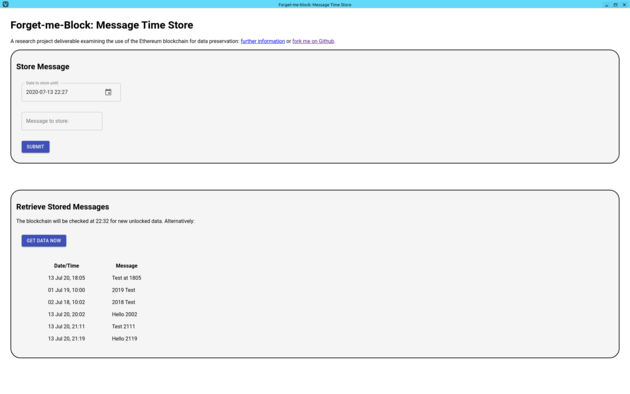Forget-me-block: Message Time Store
Jul 13, 2020 15:21 · 825 words · 4 minute read
Research Aim
As part of ongoing research into using the Ethereum blockchain for the purpose of data preservation strategies, the aim is to create the following deliverables:
- A smart contract that provides notification of previously recorded information, at a predetermined future date, or prompted by a retrieval request.
- A DApp (Decentralised Application) based around the smart contract above where the user is notified via an interface such as a web browser.
This post is intended as a summary of this research deliverable.
Challenges
The main obstacle in alerting the user at a predetermined future data, is that there is no notification function native to Ethereum, to quote the documentation:
A contract and its functions need to be called for anything to happen. There is no “cron” concept in Ethereum to call a function at a particular event automatically.
That leaves the developer with a number of choices:
- Ethereum Alarm Clock. A decentralised network which financially motivates participants to run “TimeNodes.” These nodes compete to monitor the Ethereum blockchain for time instances where smart contacts should be executed. Should the node win the right to execute the smart contract, they are rewarded in Ether. Unfortunately at time of writing however, although this system could be used for scheduling Ether transactions, there appeared little documentation on how this could be integrated within third party smart contracts.
- Aion. A third party offering a service to execute smart contracts at a predetermined time in the future, in return for payment. Advertises it can be “easily integrated into other smart contracts using a single scheduling function.”
- Client side. The developer takes responsibility for implementing a mechanism to check the smart contract at a suitable date-time within the client that is used to interact with the smart contract. The client could be a web page, smart phone app, etc.
For the purposes of this deliverable the client side method has been chosen.
Solution
Smart contract
A smart contract satisfying the aim has been deployed to the Ropsten test network at address 0x2f7BF4942D3956C117A8d99237e074E9d05D8301. It has two externally accessible functions:
- storeMsg(string memory _storedMsg, uint _unlockTime). The two arguments are the message to be stored, and the time (using unix time) it needs to be stored until. Messages are mapped against msg.sender - i.e. the users address. This means that Alice will only retrieve messages that Alice has submitted, while Bob will only see messages he has submitted. Eve will see neither.
- getMsgTimed() public view returns (StoredData[] memory). This returns an array of objects containing all messages which have passed the unlockTime defined by the user. The pragma experimental ABIEncoderV2 option has been used within the smart contract to allow objects to be returned. Solidity is notable in that although state arrays can be dynamic, memory arrays cannot be and have to be a fixed length. Resultantly when the function is called and messages exist that have not yet reached unlock time, the returned array will contain empty values for the yet unlocked messages. The single-page-application checks for empty values (specifically id) prior to presenting to the user, to ameliorate this.
It is noteworthy that although the variables that hold the users’ messages have been specified private, this only relates to whether they can be accessed by other contracts. It does not refer to their overall visibility, to quote the documentation:
Everything that is inside a contract is visible to all observers external to the blockchain. Making something private only prevents other contracts from reading or modifying the information, but it will still be visible to the whole world outside of the blockchain.
Should users wish to store truly private information, then they will need to encrypt messages prior to storing them.
DApp
A web application, written in React, has been published at forget-me-block-msg-time-store.preciouschicken.com. This single-page-application allows users to submit messages whilst deciding how long they wish to keep them ’locked’ for. It will then display unlocked messages (i.e. those which have been stored for the selected duration) on screen either a) automatically checking at 5 minute intervals or b) at user request.
The resulting DApp is as shown:
Users will require a suitable in browser wallet (e.g. Metamask) and Ropsten test network Ether, available from the Ropsten Ethereum Faucet.
Codebase
All code used is available at PreciousChicken/forget-me-block-msg-time-store.
Backlog
There is additional functionality that would improve this DApp:
- Ability for user to delete messages they have viewed. Currently users can append messages to their store, but cannot remove them.
- Use an event within smart contract to confirm to user (ideally via a toast) that their message is being stored on the blockchain
For reasons of time compression the following has been minimised:
- Test coverage
- Smart contract optimisation (specifically ensuring the least Ether possible is used)
Configuration control
This deliverable used the following software versions for the smart contract: Truffle v5.1.30, Solidity - 0.6.1 (solc-js), Node v14.4.0, Web3.js v1.2.1, truffle/hdwallet-provider v1.0.38; and for the client: ethers v5.0.5, react v16.13.1. OS was Ubuntu 20.04 (Regolith DE).
